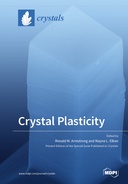Explore

Crystal Plasticity at Micro- and Nano-scale Dimensions
0 Ungluers have
Faved this Work
Login to Fave
The present collection of articles focuses on the mechanical strength properties at micro- and nanoscale dimensions of body-centered cubic, face-centered cubic and hexagonal close-packed crystal structures. The advent of micro-pillar test specimens is shown to provide a new dimensional scale for the investigation of crystal deformation properties. The ultra-small dimensional scale at which these properties are measured is shown to approach the atomic-scale level at which model dislocation mechanics descriptions of crystal slip and deformation twinning behaviors are proposed to be operative, including the achievement of atomic force microscopic measurements of dislocation pile-up interactions with crystal grain boundaries or with hard surface coatings. A special advantage of engineering designs made at such small crystal and polycrystalline dimensions is the achievement of an approximate order-of-magnitude increase in mechanical strength levels. Reasonable extrapolation of macro-scale continuum mechanics descriptions of crystal strength properties at micro- to nano-indentation hardness measurements are demonstrated, in addition to reports on persistent slip band observations and fatigue cracking behaviors. High-entropy alloy, superalloy and energetic crystal properties are reported along with descriptions of deformation rate sensitivities, grain boundary structures, nano-cutting, void nucleation/growth micromechanics and micro-composite electrical properties.
This book is included in DOAB.
Why read this book? Have your say.
You must be logged in to comment.
Rights Information
Are you the author or publisher of this work? If so, you can claim it as yours by registering as an Unglue.it rights holder.Downloads
This work has been downloaded 92 times via unglue.it ebook links.
- 92 - pdf (CC BY) at Unglue.it.
Keywords
- ab initio calculations
- activation volume
- Alloys
- anisotropic elasticity
- anode
- B2 phase
- BCC Fe nanowires
- bi-crystal
- cohesive strength
- compression
- conversion reaction
- copper single crystal
- Crack growth
- cracking
- crystal plasticity simulations
- crystal plasticity theory
- crystal size dependencies
- crystal strength
- crystallographic slip
- cutting theory
- cyclic deformation
- de-twinning
- discrete dislocation pile-up
- Dislocation
- dislocation emission
- dislocation models
- dislocation plasticity
- dislocations
- elastic properties
- Fatigue
- fatigue crack initiation
- FeCrAl
- Fracture
- Fracture mechanics
- free surface
- geometrically necessary dislocations
- grain boundaries
- Grain Boundary
- Grain growth
- Hall-Petch relation
- hardness
- HMX
- hydrogen embrittlement
- in situ electron microscopy
- IN718 alloy
- indentation creep
- indentation size effect
- interfacial delamination
- intermetallic compounds
- internal stress
- internal stresses
- Iron
- kitagawa-takahashi diagram
- lattice distortive transformations
- linear complexions
- lithium ion battery
- magnesium
- Mechanical Property
- Metals and Alloys
- micro-crystals
- micro-pillar
- micromechanical testing
- micropillar
- miniaturised testing
- Molecular Dynamics
- molecular dynamics simulation
- molecular dynamics simulations
- multiaxial loading
- nano-crystals
- nano-indentation
- nano-polycrystals
- nano-wires
- nanocrystalline
- nanocutting
- nanoflower
- nanomaterials
- Nucleation
- persistent slip band
- Phase-field Simulation
- pile-ups
- pillars
- rafting behavior
- rapid solidification
- size effect
- strain hardening
- strain hardening behavior
- strain rate
- strain rate sensitivity
- strength
- surface hard coating
- synchrotron radiation X-ray diffraction
- Technology, engineering, agriculture
- Technology: general issues
- temperature effect
- theoretical model
- Thermal stability
- tin sulfide
- twin boundaries
- Twinning
- Ultrafine-grained materials
- void formation
- whiskers
Links
DOI: 10.3390/books978-3-0365-0875-7Editions

